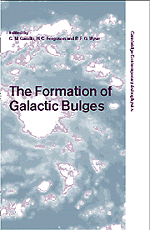Book contents
- Frontmatter
- Contents
- Preface
- Dedication: In Memory of Olin Eggen
- Part 1 Introduction
- Part 2 The Epoch of Bulge Formation
- Origin of Bulges
- Deep sub-mm Surveys: High-z ULIRGs and the Formation of Spheroids
- Ages and Metallicities for Stars in the Galactic Bulge
- Integrated Stellar Populations of Bulges: First Results
- HST-NICMOS Observations of Galactic Bulges: Ages and Dust
- Inside-Out Bulge Formation and the Origin of the Hubble Sequence
- Part 3 The Timescales of Bulge Formation
- Part 4 Physical Processes in Bulge Formation
- Part 5 Bulge Phenomenology
- Part 6 Conference Summary
- Index
Ages and Metallicities for Stars in the Galactic Bulge
from Part 2 - The Epoch of Bulge Formation
Published online by Cambridge University Press: 10 November 2010
- Frontmatter
- Contents
- Preface
- Dedication: In Memory of Olin Eggen
- Part 1 Introduction
- Part 2 The Epoch of Bulge Formation
- Origin of Bulges
- Deep sub-mm Surveys: High-z ULIRGs and the Formation of Spheroids
- Ages and Metallicities for Stars in the Galactic Bulge
- Integrated Stellar Populations of Bulges: First Results
- HST-NICMOS Observations of Galactic Bulges: Ages and Dust
- Inside-Out Bulge Formation and the Origin of the Hubble Sequence
- Part 3 The Timescales of Bulge Formation
- Part 4 Physical Processes in Bulge Formation
- Part 5 Bulge Phenomenology
- Part 6 Conference Summary
- Index
Summary
Observations of the stellar content of the Milky Way's bulge helps us to understand the stellar content and evolution of distant galaxies. In this brief overview I will first highlight some recent work directed towards measuring the history of star formation and the chemical composition of the central few parsecs of the Galaxy. High resolution spectroscopic observations by Ramirez et al. (1998) of luminous M stars in this region yield a near solar value for [Fe/H] from direct measurements of iron lines. Then I will present some results from an ongoing program by my colleagues and myself which has the objective of delineating the star formation and chemical enrichment histories of the central 100 parsecs of the Galaxy, the ‘inner bulge’. We have found a small increase in mean [Fe/H] from Baade's Window to the Galactic Center and deduce a near solar value for stars at the center. For radial distances greater than 1° we fail to find a measurable population of stars that are significantly younger than those in Baade's Window. Within 1° of the Galactic Center we find a number of luminous M giants that most likely are the result of a star formation episode not more than one or two Gyr ago.
Introduction
The structure and stellar content of the bulge of the Milky Way are often used as proxies in the study of other galactic bulges and of elliptical galaxies.
- Type
- Chapter
- Information
- The Formation of Galactic Bulges , pp. 38 - 41Publisher: Cambridge University PressPrint publication year: 2000



